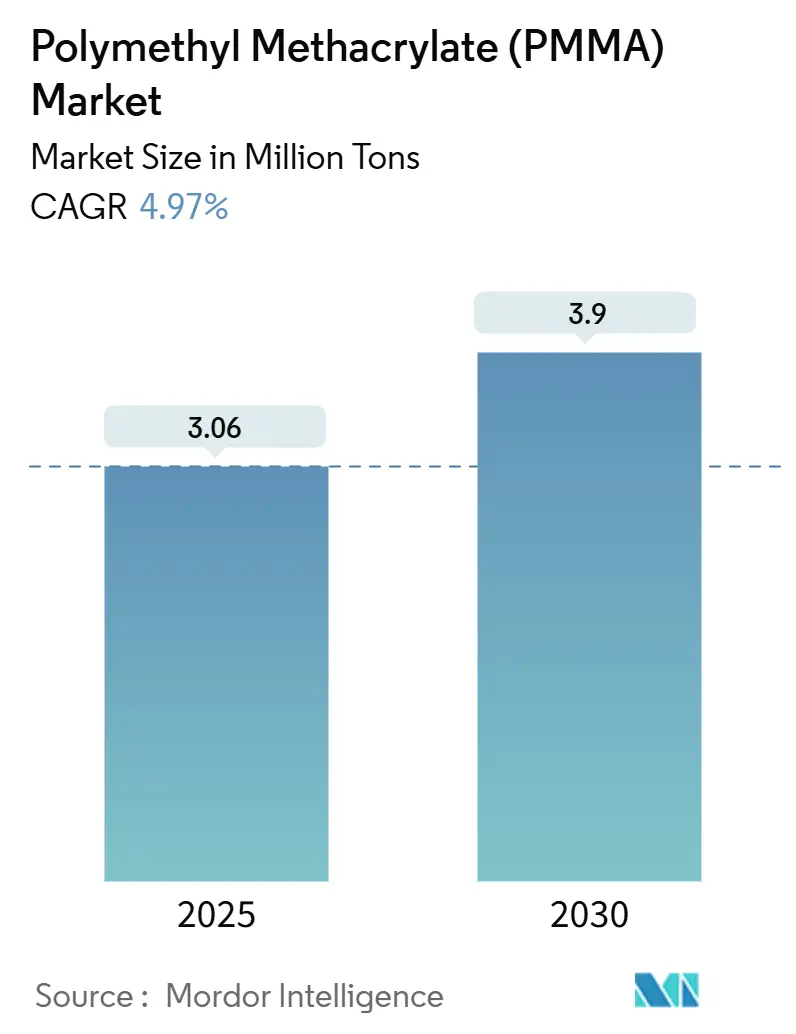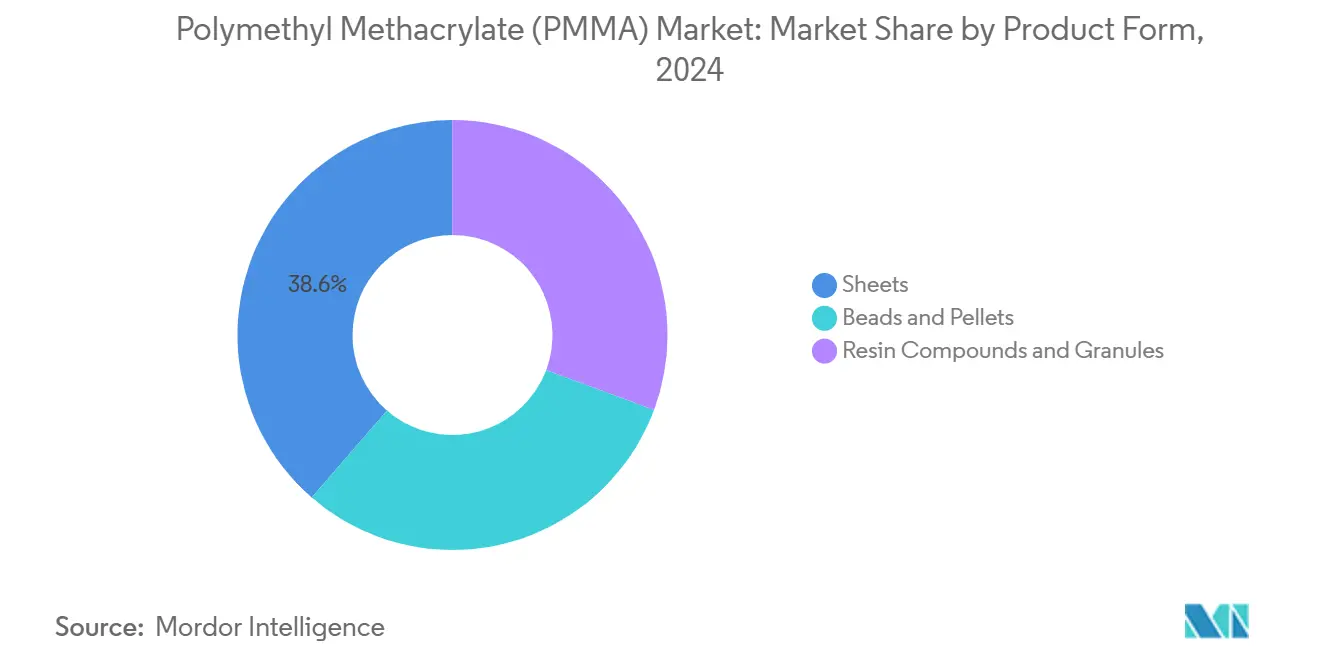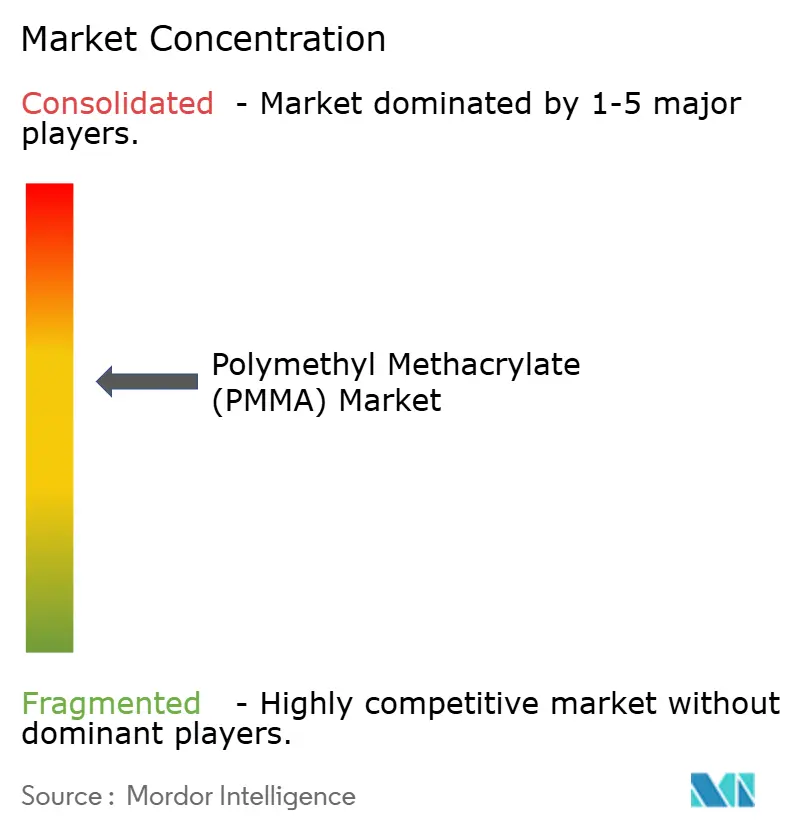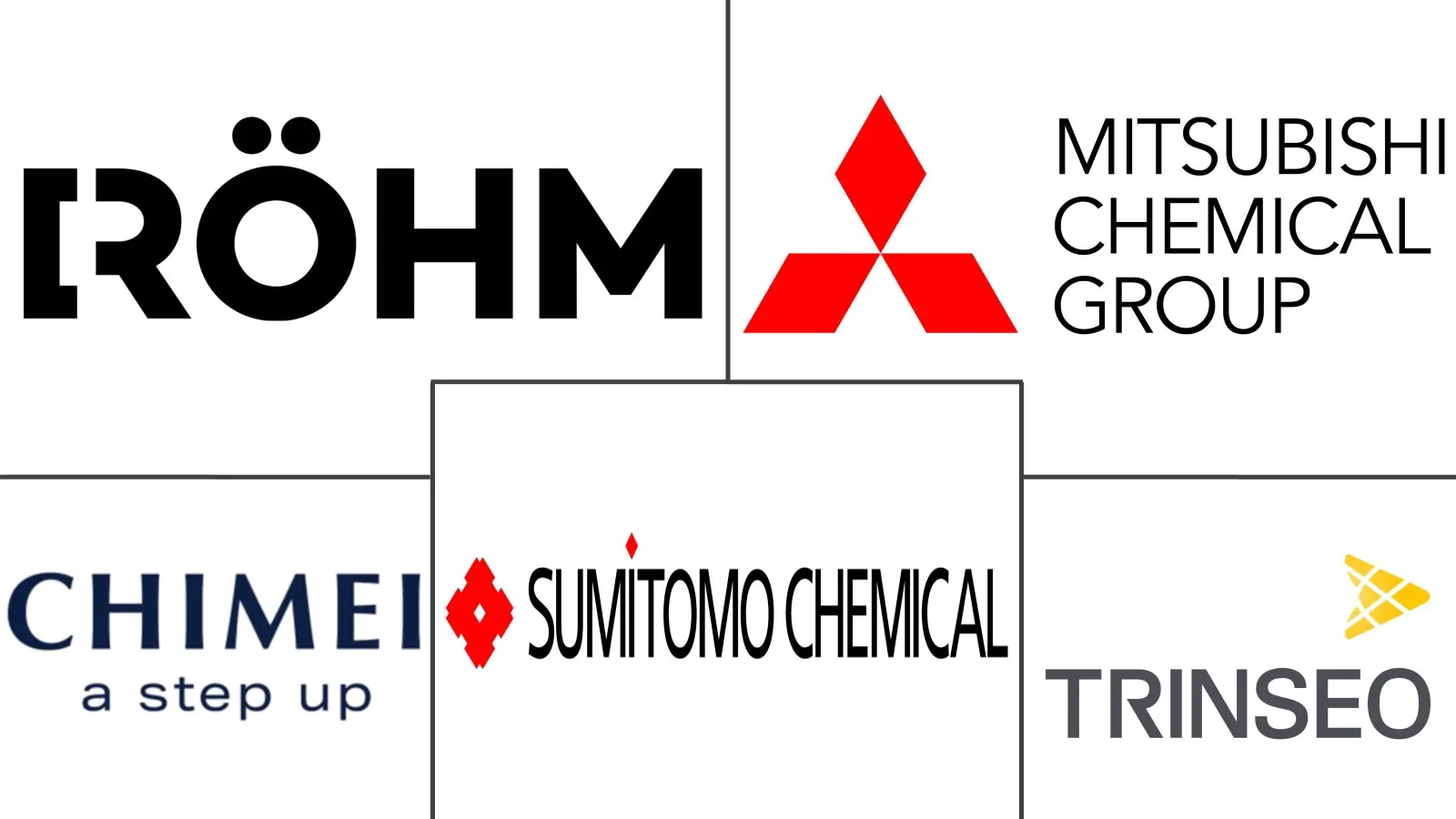Polymethyl Methacrylate (PMMA) Market Size and Share

Polymethyl Methacrylate (PMMA) Market Analysis by Mordor Intelligence
The Polymethyl Methacrylate Market size is estimated at 3.06 Million tons in 2025, and is expected to reach 3.9 Million tons by 2030, at a CAGR of 4.97% during the forecast period (2025-2030). Solid demand from automotive lightweighting, architectural glazing, and LED displays sustains growth even as methyl methacrylate (MMA) feedstock costs remain volatile. PMMA’s optical clarity, UV stability, and straightforward processing differentiate it from competing polymers, shielding volumes from substitution pressure in many core uses. Regional overcapacity—especially in China—keeps pricing competitive, while breakthrough chemical-recycling pilots open a pathway to circular production models. Producers prioritize vertical integration and specialty-grade development as defensive strategies in the PMMA market.
Key Report Takeaways
- By product form, sheets accounted for 38.64% of PMMA market size in 2024 and are projected to expand at 5.48% CAGR to 2030.
- By end-user industry, building and construction held 25.97% of PMMA market share in 2024; aerospace is projected to grow at a 5.67% CAGR through 2030.
- By geography, Asia-Pacific commanded 50.70% of PMMA market share in 2024 while advancing at a 5.31% CAGR over the forecast period.
Global Polymethyl Methacrylate (PMMA) Market Trends and Insights
Drivers Impact Analysis
| Driver | (~) % Impact on CAGR Forecast | Geographic Relevance | Impact Timeline |
|---|---|---|---|
| Automotive lightweighting & lighting | +0.8% | APAC & Europe | Medium term (2-4 years) |
| Architectural glazing uptake | +0.6% | Asia-Pacific led | Long term (≥ 4 years) |
| LED signage & display expansion | +0.4% | APAC core | Short term (≤ 2 years) |
| Medical & dental adoption | +0.3% | North America & Europe | Medium term (2-4 years) |
| Chemical-recycling breakthroughs | +0.2% | Europe & North America | Long term (≥ 4 years) |
| Source: Mordor Intelligence | |||
Automotive lightweight and lighting demand
Electric-vehicle makers specify PMMA for panoramic sunroofs, tail-lamp covers, and sensor housings because the polymer weighs 50% less than glass yet offers high optical quality. The technology shift toward adaptive LED systems amplifies demand for Röhm’s light-management grades that shape precise beam patterns. Additional pull comes from autonomous-vehicle LiDAR lenses requiring low birefringence. Despite new impact-resistant polycarbonate (PC) copolymers, PMMA market resilience persists where cost and UV durability outweigh marginal toughness gains.
Architectural Glazing and Façade Adoption
Smart-building envelopes now integrate PMMA sheets embedded with sensors and heating elements that manage daylight, condensation, and self-cleaning functions[1]UVTECO, “Architectural Acrylic Glazing Trends 2024,” uvteco.com. PMMA transmits 92–93% visible light versus 86–89% for PC, supporting energy-efficiency credits under European building codes. Digital printing on PMMA panels enables complex façade designs without multi-material assemblies, reducing installation time. Fire-code restrictions in high-rise projects still cap penetration, yet long-term warranties and UV resistance keep PMMA competitive where clarity and aesthetics dominate.
Expansion of LED Signage & Display Industry
Micro-LED backlighting requires light-guide plates with tight color uniformity, and PMMA’s refractive-index profile delivers higher luminous efficiency than PC for large panels. Smartphone and automotive-cockpit displays adopt ultra-thin PMMA guides that integrate optical micro-structures formed in-mold, eliminating secondary etching. Asia-Pacific advertising markets further strengthen near-term tonnage as retailers upgrade to digital storefronts. AR/VR headsets add an emerging niche, though they demand premium PMMA grades with anti-scratch coatings.
Growth in Medical & Dental PMMA Use
Biocompatible PMMA finds new roles in 3D-printed prosthetics, radiolucent orthopedic plates, and same-day CAD/CAM dental crowns. FDA pathways remain established, shortening time-to-market for device OEMs (original equipment manufacturers) compared with newer polymers. Single-use medical products benefit from PMMA’s compatibility with gamma sterilization. Aging populations in Europe and Japan add baseline volume growth, although heightened scrutiny on polymer life-cycle impacts will require transparent material passports.
Restraints Impact Analysis
| Restraint | (~) % Impact on CAGR Forecast | Geographic Relevance | Impact Timeline |
|---|---|---|---|
| Volatile MMA feedstock pricing | -0.7% | Global | Short term (≤ 2 years) |
| Substitution threat from polycarbonate and glass | -0.5% | North America & Europe | Medium term (2-4 years) |
| Stringent single-use plastics regulation | -0.3% | Europe expanding to APAC | Long term (≥ 4 years) |
| Source: Mordor Intelligence | |||
Volatile MMA Feedstock Pricing
MMA price swings mirror petrochemical feedstock trends, magnified by energy-intensive processes. Trinseo raised European PMMA prices by EUR 250 / t in March 2025 after propylene costs surged, compressing converter margins[2]Trinseo, “Price Increase Announcement March 2025,” trinseo.com. Import-dependent regions such as Europe remain exposed until bio-based or recycled MMA scales commercially. Asian producers with back-integrated acetone routes gain cost advantage, exacerbating global price disparities.
Substitution Threat from Polycarbonate and Glass
Sabic’s weatherable PC now approaches PMMA clarity while surpassing it in impact resistance, tempting automakers to switch tail-lamp covers and spoilers. Laminated glass prices have fallen, challenging PMMA in skylight glazing where fire codes are strict. Electronics brands prefer tougher PC (polycarbonate) housings for premium phones, limiting PMMA share despite lower material cost.
Segment Analysis
By Product Form: Sheets Drive Market Leadership
Sheets captured 38.64% of PMMA market share in 2024 and will expand at a 5.48% CAGR through 2030, underpinning USD-denominated sales growth proportionate with the overall PMMA market size for this category. Thinner-gauge extrusion lines now deliver robust mechanical stability that satisfies automotive sunroof load requirements, enabling vehicle makers to shave weight without sacrificing safety margins. Cast-acrylic sheets retain premium positioning—especially in LED edge-lit panels—thanks to tighter thickness tolerances that minimize optical defects.
Beads and pellets follow as the workhorse feedstocks for injection-molded lenses, appliance knobs, and medical parts. Formulators increasingly incorporate impact modifiers and UV absorbers at the compounding stage, trading some transparency for higher durability in outdoor signage. Granules tailored for laser engraving open niche revenue streams in trophy and giftware segments. Although growth lags the sheet category, resin compounds support consistent PMMA market demand by serving a wider span of short-run customized products.

Note: Segment shares of all individual segments available upon report purchase
By End-user Industry: Construction Leads, Aerospace Accelerates
Building and construction held 25.97% of PMMA market size in 2024, driven by skylights, noise-barrier panels, and façade cladding that require high light transmittance and weatherability. Urbanization across India, Indonesia, and Vietnam sustains baseline demand, while European retrofits emphasize daylighting to meet stricter energy codes.
Aerospace, though a smaller volume user, posts the fastest 5.67% CAGR owing to ramp-ups in single-aisle aircraft output and PMMA’s entrenched role in cockpit and passenger windows. Weight savings translate directly into fuel-cost reductions, giving PMMA a competitive moat over glass and PC in long-haul cabins. Automotive remains a vital pillar for tail lamps and interior trims but faces higher substitution risk, prompting compounders to introduce scratch-resistant grades. Electrical and electronics continue to benefit from LED diffusion lenses, whereas industrial machinery uses PMMA guards where high clarity aids operator safety.

Note: Segment shares of all individual segments available upon report purchase
Geography Analysis
Asia-Pacific accounted for 50.70% of PMMA market share in 2024 on the strength of China’s large converter base and India’s infrastructure build-out. However, Chinese overcapacity compresses margins, pushing domestic players toward specialty exports and prompting new capacity curtailments. India’s commitment of USD 1.1 billion to an integrated MMA-PMMA complex aims to cut import reliance and seize regional share by 2027. Japan and South Korea anchor high-value niches tied to electronics and optics, mitigating price erosion seen in commodity grades.
North America remains a mature but lucrative arena where sustainability attributes command premiums. LG Chem’s 2025 bio-acrylic acid launch positions North American converters to offer renewable-content PMMA products in cosmetics packaging. Aerospace recovery and electric-vehicle investments bolster baseline volumes despite imported sheet competition.
Europe focuses on circularity; chemical-recycling pilots in Germany and the Netherlands receive policy support and generate early commercial lots that meet recycled-content quotas. Nevertheless, exposure to imported MMA feedstocks leaves European PMMA producers vulnerable to energy-driven cost spikes. South American and Middle-Eastern markets remain small but promising as infrastructure megaprojects demand transparent noise barriers and large-format signage.

Competitive Landscape
The Polymethyl Methacrylate (PMMA) market is moderately consolidated. Mitsubishi Chemical, Röhm, and Asahi Kasei led global shipments, while Trinseo vaulted into the top tier after acquiring Arkema’s PMMA assets in 2024. Strategic focus has shifted from scale to integration. Röhm shuttered U.S. MMA lines to concentrate production near European customers and cut logistics costs, whereas Mitsubishi Chemical leverages captive MMA feedstock in Japan to secure supply. Digital supply-chain dashboards and predictive-maintenance analytics backstop efficiency gains, giving adopters added resilience against MMA cost swings and competitive pricing pressures within the PMMA market.
Polymethyl Methacrylate (PMMA) Industry Leaders
-
Röhm GmbH
-
Mitsubishi Chemical Group Corporation
-
CHIMEI
-
Trinseo
-
Sumitomo Chemical Co., Ltd.
- *Disclaimer: Major Players sorted in no particular order

Recent Industry Developments
- May 2025: Asahi Kasei Corporation revealed plans to exit the businesses of methyl methacrylate (MMA) monomer, cyclohexyl methacrylate (CHMA), PMMA acrylic resin, and SB latex. The Kawasaki City plant will halt production of these chemicals, with shutdowns slated between March 2026 and September 2027.
- September 2024: Sumitomo Chemical Co., Ltd. announced plans to shutter two of the three production lines dedicated to methyl methacrylate (MMA) monomer and polymethyl methacrylate (PMMA) at its wholly-owned subsidiary, Sumitomo Chemical Asia Pte Ltd, in Singapore. This move will slash the site's PMMA production capacity by about 70%.
Global Polymethyl Methacrylate (PMMA) Market Report Scope
Aerospace, Automotive, Building and Construction, Electrical and Electronics, Industrial and Machinery are covered as segments by End User Industry. Africa, Asia-Pacific, Europe, Middle East, North America, South America are covered as segments by Region.| Sheets |
| Beads and Pellets |
| Resin Compounds and Granules |
| Automotive |
| Building and Construction |
| Electrical and Electronics |
| Aerospace |
| Industrial Machinery and Equipment |
| Other End-user Industries |
| Asia-Pacific | China |
| Japan | |
| India | |
| South Korea | |
| Australia | |
| Malaysia | |
| Rest of Asia-Pacific | |
| North America | United States |
| Canada | |
| Mexico | |
| Europe | Germany |
| France | |
| Italy | |
| United Kingdom | |
| Russia | |
| Rest of Europe | |
| South America | Brazil |
| Argentina | |
| Rest of South America | |
| Middle East and Africa | Saudi Arabia |
| South Africa | |
| United Arab Emirates | |
| Nigeria | |
| Rest of Middle East and Africa |
| By Product Form | Sheets | |
| Beads and Pellets | ||
| Resin Compounds and Granules | ||
| By End-user Industry | Automotive | |
| Building and Construction | ||
| Electrical and Electronics | ||
| Aerospace | ||
| Industrial Machinery and Equipment | ||
| Other End-user Industries | ||
| By Geography | Asia-Pacific | China |
| Japan | ||
| India | ||
| South Korea | ||
| Australia | ||
| Malaysia | ||
| Rest of Asia-Pacific | ||
| North America | United States | |
| Canada | ||
| Mexico | ||
| Europe | Germany | |
| France | ||
| Italy | ||
| United Kingdom | ||
| Russia | ||
| Rest of Europe | ||
| South America | Brazil | |
| Argentina | ||
| Rest of South America | ||
| Middle East and Africa | Saudi Arabia | |
| South Africa | ||
| United Arab Emirates | ||
| Nigeria | ||
| Rest of Middle East and Africa | ||
Market Definition
- End-user Industry - Building & Construction, Automotive, Aerospace, Industrial Machinery, Electrical & Electronics, and Others are the end-user industries considered under the polymethyl methacrylate market.
- Resin - Under the scope of the study, virgin polymethyl methacrylate resin in the primary forms such as powder, granules, etc. are considered.
| Keyword | Definition |
|---|---|
| Acetal | This is a rigid material that has a slippery surface. It can easily withstand wear and tear in abusive work environments. This polymer is used for building applications such as gears, bearings, valve components, etc. |
| Acrylic | This synthetic resin is a derivative of acrylic acid. It forms a smooth surface and is mainly used for various indoor applications. The material can also be used for outdoor applications with a special formulation. |
| Cast film | A cast film is made by depositing a layer of plastic onto a surface then solidifying and removing the film from that surface. The plastic layer can be in molten form, in a solution, or in dispersion. |
| Colorants & Pigments | Colorants & Pigments are additives used to change the color of the plastic. They can be a powder or a resin/color premix. |
| Composite material | A composite material is a material that is produced from two or more constituent materials. These constituent materials have dissimilar chemical or physical properties and are merged to create a material with properties unlike the individual elements. |
| Degree of Polymerization (DP) | The number of monomeric units in a macromolecule, polymer, or oligomer molecule is referred to as the degree of polymerization or DP. Plastics with useful physical properties often have DPs in the thousands. |
| Dispersion | To create a suspension or solution of material in another substance, fine, agglomerated solid particles of one substance are dispersed in a liquid or another substance to form a dispersion. |
| Fiberglass | Fiberglass-reinforced plastic is a material made up of glass fibers embedded in a resin matrix. These materials have high tensile and impact strength. Handrails and platforms are two examples of lightweight structural applications that use standard fiberglass. |
| Fiber-reinforced polymer (FRP) | Fiber-reinforced polymer is a composite material made of a polymer matrix reinforced with fibers. The fibers are usually glass, carbon, aramid, or basalt. |
| Flake | This is a dry, peeled-off piece, usually with an uneven surface, and is the base of cellulosic plastics. |
| Fluoropolymers | This is a fluorocarbon-based polymer with multiple carbon-fluorine bonds. It is characterized by high resistance to solvents, acids, and bases. These materials are tough yet easy to machine. Some of the popular fluoropolymers are PTFE, ETFE, PVDF, PVF, etc. |
| Kevlar | Kevlar is the commonly referred name for aramid fiber, which was initially a Dupont brand for aramid fiber. Any group of lightweight, heat-resistant, solid, synthetic, aromatic polyamide materials that are fashioned into fibers, filaments, or sheets is called aramid fiber. They are classified into Para-aramid and Meta-aramid. |
| Laminate | A structure or surface composed of sequential layers of material bonded under pressure and heat to build up to the desired shape and width. |
| Nylon | They are synthetic fiber-forming polyamides formed into yarns and monofilaments. These fibers possess excellent tensile strength, durability, and elasticity. They have high melting points and can resist chemicals and various liquids. |
| PET preform | A preform is an intermediate product that is subsequently blown into a polyethylene terephthalate (PET) bottle or a container. |
| Plastic compounding | Compounding consists of preparing plastic formulations by mixing and/or blending polymers and additives in a molten state to achieve the desired characteristics. These blends are automatically dosed with fixed setpoints usually through feeders/hoppers. |
| Plastic pellets | Plastic pellets, also known as pre-production pellets or nurdles, are the building blocks for nearly every product made of plastic. |
| Polymerization | It is a chemical reaction of several monomer molecules to form polymer chains that form stable covalent bonds. |
| Styrene Copolymers | A copolymer is a polymer derived from more than one species of monomer, and a styrene copolymer is a chain of polymers consisting of styrene and acrylate. |
| Thermoplastics | Thermoplastics are defined as polymers that become soft material when it is heated and becomes hard when it is cooled. Thermoplastics have wide-ranging properties and can be remolded and recycled without affecting their physical properties. |
| Virgin Plastic | It is a basic form of plastic that has never been used, processed, or developed. It may be considered more valuable than recycled or already used materials. |
Research Methodology
Mordor Intelligence follows a four-step methodology in all our reports.
- Step-1: Identify Key Variables: The quantifiable key variables (industry and extraneous) pertaining to the specific product segment and country are selected from a group of relevant variables & factors based on desk research & literature review; along with primary expert inputs. These variables are further confirmed through regression modeling (wherever required).
- Step-2: Build a Market Model: In order to build a robust forecasting methodology, the variables and factors identified in Step-1 are tested against available historical market numbers. Through an iterative process, the variables required for market forecast are set and the model is built on the basis of these variables.
- Step-3: Validate and Finalize: In this important step, all market numbers, variables and analyst calls are validated through an extensive network of primary research experts from the market studied. The respondents are selected across levels and functions to generate a holistic picture of the market studied.
- Step-4: Research Outputs: Syndicated Reports, Custom Consulting Assignments, Databases & Subscription Platforms








